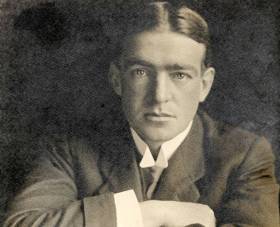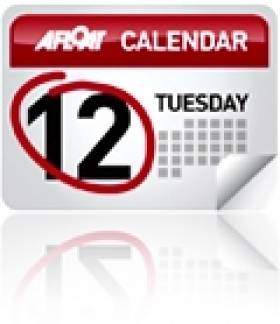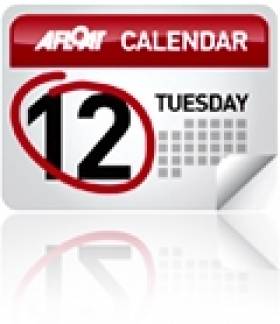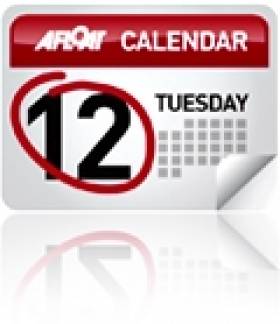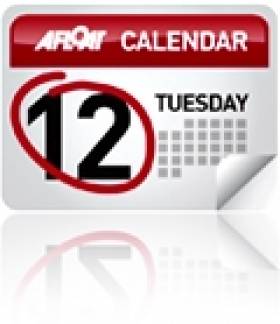Displaying items by tag: Maritime Museum
Arklow Newbuild Awaiting For Orders Offshore of the Irish East Coast Port With Maritime Museum Along Its Quay
One of the newest dry-cargo vessels of Arklow Shipping’s Dutch flagged fleet, Afloat tracked today at anchor off the Co. Wicklow port, writes Jehan Ashmore.
Arklow Gem had departed Liverpool yesterday evening to arrive off Arklow this morning and this follows yesterday’s coverage of an even newer fleetmate, Arklow Rambler (see, pending maiden Irish port of call).
The Dutch flagged G series Arklow Gem which is the leadship, had departed from the other side of the Irish Sea, at the Alexandra Branch No. 2 Dock of the Merseyside port. As of this afternoon, the 5,150 dwt newbuild continues to remain at sea awaiting orders whilst at anchor in Arklow Bay.
While in the port, along the North Quay of the River Avoca is the Arklow Maritime Heritage Museum which focuses on its boat-building, lifeboat and fishing traditions, and not surprisingly featuring photographs and models regarding the town’s famous shipping company run by the Tyrrell family.
The distinctive green hulls of the combined Arklow Shipping fleet of Irish and Dutch flagged vessels involve their short-sea fleet of dry-cargo ships trading in European waters. Whereas, Arklow Shipping Ltd's Irish-only registered fleet also includes medium to larger bulk-carriers, operating deep-sea on a global scale. Of the largest bulkers are the 34,905 dwat twins. Arklow Spirit which today is off Spain at the Tarragonna anchorage in the Meditterranean while Arklow Spray is in Mexico but on the west coast in Manzanillo on the Pacific Ocean.
Also amongst the museum's exhibits and displays located at the Bridgewater Shopping Centre, is a video of the launch of the B class Arklow Beach of 8,660dwt built almost a decade ago by Ferus Smit for Arklow Shipping Nederland B.V. The same shipyard is currently constructing the G series in which so far three have been completed for the Dutch division based in Rotterdam.
The second of the series is Arklow Glen which is in service, having made a recent passage from Aberdeen, Scotland to Seville, Spain where the short-sea trader is currently located at the inland port. As for the third newbuild, Arklow Globe was only launched last month at their Dutch inland shipyard in Westerbroek, outside Groningen.
A further two newbuilds are to be constructed in the five-ship series and will be flagged in the Netherlands.
The Robert Halpin Exhibition at Dun Laoghaire Harbour's National Maritime Museum was formally opened by Dublin Port Company Chief Executive, Eamon O'Reilly in late April.
As Afloat reported previously, the exhibition celebrates Captain Halpin’s involvement in the laying of the transatlantic cables in 1866.
Halpin was born at the Bridge Tavern Wicklow in 1836 and died on 20 January 1894 at Tinakilly, Wicklow. He captained the Brunel-designed steamship SS Great Eastern which laid transoceanic telegraph cables earning Halpin the nickname 'Mr. Cable'.
The cable laying started a process which has evolved into our modern-day system of mass communication.
Various facets of Captain Halpin’s life and the process of cable-laying are featured in the exhibition.
 Robert Halpin Exhibition at Dun Laoghaire Harbour's National Maritime Museum
Robert Halpin Exhibition at Dun Laoghaire Harbour's National Maritime Museum
Other speakers at the launch event were Seamus O’Connor (Maritime Museum), Jim Rees ( Arklow Museum) and Councillor Lettie McCarthy (Cathaoirleach D.L.R. CoCo)
The museum is open 7 days a week from 11 am to 5 pm.
New Dun Laoghaire Harbour Exhibition About Irish Maritime Legend Captain Robert Halpin
The National Maritime Museum of Ireland, at Dun Laoghaire Harbour, has opened a revamped exhibition on Wicklowman Captain Robert Halpin and his adventures and achievements at sea.
The exhibition has three strands: Captain Halpin himself and his recently restored naval uniform; the ship he commanded, the SS Great Eastern; and his achievement in laying the first successful trans-Atlantic telegraph cable. Most of the exhibits are part of the “Halpin Collection”, donated to the Museum by the Halpin family.
Maritime legend
Captain Robert Halpin is an Irish maritime legend. He was born in Wicklow town on 17th February 1836 and went to sea when he was 11 years old. After a varied career at sea, in June 1865 he was appointed chief officer of the Great Eastern, the world’s largest ship. She had been unsuccessful as a passenger ship but was altered to lay a telegraph cable across the Atlantic from Ireland to America. Halpin spent many years as a highly respected commander on the Great Eastern, and was also a popular host to the vast number of guests and spectators that the ship carried. When Halpin retired from the sea he bought Tinakilly House in Wicklow, became involved in politics, and finally died in January 1894. Having survived many years of peril on the high seas, he sadly died as a result of gangrene contracted while cutting his toenails.
Largest ship in the world
The Great Eastern was designed by the great Victorian engineer, Isambard Kingdom Brunel, and when she was launched in 1858 she was the largest ship in the world. She was designed to carry 4,000 passengers and could travel around the world without refuelling. She was powered by sails, paddle wheels, and a screw propeller, and had six masts named after the days of the week from Monday to Saturday. Eight years after she was launched, she was refitted as a cable-laying ship and, as the only ship afloat that could hold the necessary amount of cable, she laid the first successful telegraph cable across the Atlantic from Ireland to America. She ended life as a floating music hall and gym and one of her masts, “Thursday”, is now the flagpole at Liverpool Football Club.
Cable to North America
In 1866 the Great Eastern laid a telegraph cable from Valentia Island in Co Kerry to Hearts Content in Newfoundland, Canada. The first cable broke after 1660 miles (2670 km), just short of halfway across. Next year they tried again, this time successfully, when Halpin, as First Officer of the ship, really made his name by navigating the ship back to the first broken cable in 2000 feet (610 metres) of water, picking it up, splicing it and finishing the job.
Rare dress uniform and sword
 Halpin's Royal Navy Reserve Officers Dress Uniform
Halpin's Royal Navy Reserve Officers Dress Uniform
The Maritime Museum’s Halpin Collection includes his Royal Navy Reserve Officers Dress Uniform, including tailcoat, epaulettes, and dress sword. President Michael D. Higgins used Halpin’s sword to officially open the newly refurbished Museum in 2012.
The uniform was recently restored to the highest possible standard by an expert textile conservator and is now proudly displayed on a custom conservation/display mannequin. The restoration included cleaning, removal of creases and distortions, and polishing of metal elements. The Heritage Council and Dublin Port Company generously supported the restoration and new display cabinet.
 Halpin's sword handle
Halpin's sword handle
The Halpin Collection
The Museum’s Halpin Exhibition also includes the uniform, a model of the SS Great Eastern, paintings of Halpin and of the ship, various personal effects of Halpin (including even his teapot!), a short video about his life and career and a fun interactive quiz for all the family.
Open every day
The Maritime Museum is located in the old Mariners’ Church on Haigh Terrace, less than five minutes’ walk from Dun Laoghaire DART Station, and is open every day from 11 am to 5 pm. The Halpin Exhibition is a permanent exhibition included in the standard ticket price. The new exhibition will be officially launched by Eamonn O’Reilly, CEO of Dublin Port Company, on 21st April 2022, but is fully open for visitors now.

Podcast: Shackleton, Blue Economy & Open Sea Swimming
Hello and welcome aboard your maritime programme Seascapes, this week we bring you highlights from the unveiling of a fine sculture by Mark Richards in Athy, Co Kildare on the centenary to the day of the rescue of the Endurance crew from Elephant Island and the unveiling of a sculpture by Mark Richards of Sir Ernest Shackleton beside the Athy Heritage Centre in his home place complete with an Honour Guard from the Irish Naval Service, we’ll be talking to Kevin Kenny of Athy Heritage Centre ; Commander Cormac Rynne of the Irish Naval Service; Arts Officer Lucina Russell and Jack L who performed “The Wearin’ of the Green” and we also met up with Jonathan Shackleton ...... also this week Dr Gordon Dalton of MAREI on the Maribe project and the outcome of a recent conference held in Cork....first this week here on Seascapes to our Galway Studios where we can hear from Features Editor Gery Flynn of Inshore Ireland Magazine on what’s in the latest edition ...
Features Editor of Inshore Ireland magazine – Gery Flynn ....next here on Seascapes to Athy in Co Kildare where .............to coincide with the very day a hundred years ago on the 30th of August that epic rescue of The crew of The Endurance from Elephant Island was marked by a sculpture by Mark Richards being unveiled by the Mayor of Kildare , Cllr Ivan Keatley and Alexandra Shackleton with an honour guard drawn from the Irish Naval Service in attendance ....
Also present for the ceremony was local musician Jack L who spoke briefly to Seascapes before he performed this song...
Jack Lukeman performing The Wearin’ of the Green” next we spoke to Jonathan Shackleton ...
Also in attendance was Commander Cormac Rynne of the Irish Naval Service.....
From Commander Cormac RYNNE to Kildare Arts Officer , Lucina RUSSELL..
The Athy Heritage Centre is in the heart of the town and is hosting an exhibition “ By Endurance We Conquer “running until February of next year....
Lets have a final word from Kevin Kenny of Athy Heritage Centre....
MARIBE is Marine Investment for the Blue Economy , Dr Gordon Dalton who is based at MaREI ERI, at University College Cork is Maribe Project Coordinator , we last talked to him earlier this year
Dr Gordon Dalton of MAREI /ERI – Maribe Project Coordinator
We wish swimmers the “Swim Sisters” team of Lynsey Dunne -Connacht, Mary Bolger-Hinds- Leinster, Claudine Hughes -Ulster and Maighread McMahon from Munster , they will attempt to become the first four provinces, all-female team to swim the length of the largest freshwater lake in these islands , Lough Neagh – a distance of approximately 30.5km.
The “Swim Sisters “ are four experienced open water swimmers and members of the Irish Long Distance Swimming Association. And it was through their love of open water swimming that the team the " Swim Sisters " came together. Two of them , Lynsey & Maighread are veterans of two successful English Channel relay swims.You can read more about their swim on the Seascapes webpage....
That’s it for this week on your maritime programme, on the sound desk this week Niall O Sullivan , next week here on Seascapes we bring you the story of the Aud and Sir Roger Casement and highlights from the commemoration held on Banna Strand earlier this year at Easter .....Grainne McPolin was there for Seascapes when she spoke with with H.E. President Michael D Higgins we hear from local historian Pat Lawlor about Sir Roger Casement the humanitarian, explorer and seafarer and descendants of Captain Monteith and Sir Roger Casement ; until next Friday night, tight lines and fair sailing.”
A popular wedding venue a Wedding Fair is being held in The National Maritime Museum of Ireland, Haigh Terrace, Dun Laoghaire on Sunday 18th September open from 12 noon....
Ireland’s National Maritime Museum is housed in Dun Laoghaire’s 180-year-old Mariners Church, directly opposite the new DLR Lexicon library and easily accessible by DART suburban train and several bus services. The museum’s greatest artefact is probably the building itself as it is one of a few custom built places of worship for seafarers remaining intact in the world to-day.
Experienced guides will bring you on a voyage of discovery enthralling you with stories of discovery, heroism, war and disasters at sea. You will learn about maritime history, exploration, navigation, radio, deep-sea cable technology, nature, wildlife and view art inspired by the sea.
See the 10-tonne revolving Baily Optic, try the electrified steam engine and pause to reflect at the Titanic exhibit, the re-created radio room, the Royal Navy prisoners docks and the war memorial. Try sailor’s knots, learn how they lift heavy weights, be photographed with the pirate, research in the library, visit the shop and café and much more.
'Bag' that Maritime Museum
A 'Bag-Packing Day' in aid of the Maritime Museum in Dun Laoghaire is to start tomorrow, writes Jehan Ashmore.
The fund-raising activity will also run on the Friday and Saturday at the Tesco Bloomfield Shopping Centre off Lower Georges Street.
Volunteers are invited to assist in providing two hours of their time to help raise funds for the Maritime Museum which is currently closed due to ongoing renovation work.
For further information please call (01) 214 3964 or email: [email protected]
The museum is located in the former Mariners Church and is run by the Maritime Institute of Ireland (M.I.I.). The museum is to be officially reopened in March 2012, however they intend to be open to the public before their 70th anniversary in October 2011.
Information about the M.I.I. and the museum which welcomes new members can be found on www.mariner.ie
Maritime Museum Needs You!
The Maritime Institute of Ireland (M.I.I.) is looking for volunteers to assist in the running of the maritime museum, located in the former Mariners' Church in Dun Laoghaire, Co. Dublin.
A Volunteers Induction Meeting is to be held on 15 February at 8 p.m. in the Dun Laoghaire Club. Please register in advance. For further details click this link.
In addition to the various roles and activities required in the operation of the museum, the institute, are looking for people who can assist from time to time with the setting up of special exhibitions, the making of DVDS to go with displays and website maintenance.
For general information and other updates about the museum log on to www.mariner.ie
Lecture: “The Newfoundland Voyage”
All are welcome, bar and refreshments and a voluntary contribution is appreciated. Further lectures will be held throughout the winter, mostly on the third Thursday of each month and in the Stella Maris. Note that the March lecture is due to be held on the 'fourth' Thursday of that month.
For further information about lectures and updates on the M.I.I's maritime museum in Dun Laoghaire, log on to www.mariner.ie
Lecture: "Historical Diving in Ireland"
The Maritime Institute of Ireland (M.I.I.) hosts a Winter /Spring lecture series. The first lecture of the new year is 'Historical Diving in Ireland' by Dr Edward Bourke.
The lecture is on 20 January and starts at 8pm and is to be held in the Stella Maris Seafarers' Club, Beresford Place. The club is located beside Busaras and faces opposite the rear of the Customs House. Nearby is the Irish Life Center (ILAC) which is convenient for car-parking and buses, the 'Red' Luas (Busaras stop) and DART stops at Connolly /Tara St. stations.
All are welcome, bar and refreshments and a voluntary contribution is appreciated. Further lectures will be held throughout the winter, mostly on the third Thursday of each month and in the Stella Maris. For further information about lectures and updates on the the M.I.I's maritime museum in Dun Laoghaire, logon to www.mariner.ie
Maritime Museum Seeks Volunteers
Over the last three years the museum has been closed for major restoration to the historic building which in fact is the greatest artefact on display. The museum is believed to contain the largest maritime collection of artefacts in Ireland.
For further details please contact Breasal O Caollai, Hon. Secretary Mob: 086-0745402 Email [email protected] and www.mariner.ie




























